In the upper limb, the shoulder is usually less affected than the elbow, the wrist and the hand.
Shoulder
The shoulder is usually held close to the body, and raising the arm (“abduction”) or bringing the hand away from the body (“external rotation”) can be difficult.
This creates difficulties in washing, dressing, and reaching distant objects.
Elbow
 Very often, the elbow is permanently flexed during activities (walking, running, activities with the contra-lateral hand), but can relax and extend at rest. Sudden stimuli such as a loud noise, pain… may cause it to flex even more. Clinical examination helps to distinguish between spasticity, which can be overcome by gentle but firm prolonged traction in extension, and muscle contracture which does not give way. When severe, this deformity makes use of the hand almost impossible.
Very often, the elbow is permanently flexed during activities (walking, running, activities with the contra-lateral hand), but can relax and extend at rest. Sudden stimuli such as a loud noise, pain… may cause it to flex even more. Clinical examination helps to distinguish between spasticity, which can be overcome by gentle but firm prolonged traction in extension, and muscle contracture which does not give way. When severe, this deformity makes use of the hand almost impossible.
But there are other patterns, for example the elbow can be permanently straight, fully extended, which renders most activities of daily living even more difficult, or impossible (feeding).
Wrist
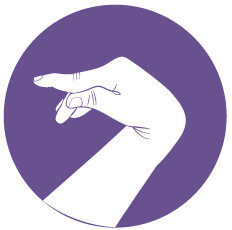 The wrist is usually flexed, and turned palm down (“pronation”).
The wrist is usually flexed, and turned palm down (“pronation”).
It is difficult, and sometimes even impossible for the patient to bring the wrist into extension because of the hypertonic (spastic) flexor muscles. But it can be done passively, i.e. if one takes the wrist and brings it gently but firmly into extension.
Like in the elbow, clinical examination helps to distinguish between spasticity, and muscle contracture. If it is contracted, the wrist is permanently flexed, even at rest, and cannot be brought into extension passively. Because of this flexed position, it may be very difficult to move and use the fingers, even if they are otherwise normal.(picto 3: caroline 9) Correction of the deformity (physical therapy, splint, botulinum toxin, surgery) improves the function of the hand a great deal.

The “pronation” and the “ulnar deviation” deformities are frequent in spastic children.
With the arm resting along the body and the elbow flexed at a right angle (90°), pronation is the position of the hand palm down, as opposed to supination, which is the position palm up.
Ulnar deviation is the position where the wrist is neither flexed nor extended, but bent in the direction of the little finger, as opposed to radial deviation, where it is bent in the direction of the thumb. This deformity occurs less often in spastic adults.
Fingers
The position of the fingers is very variable.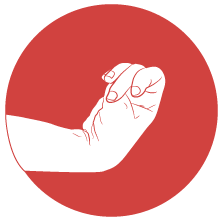
They can be closed, making a tight fist around the thumb, which is clenched into the palm. This position renders the hand useless. If there is only spasticity and no contracture, the fingers can usely be progressively brought into passive extension with firm but gentle traction. But the deformity soon recurs within a few minutes. When severe, this tight position may generate hygiene problems: unpleasant sweating, maceration, and even skin ulceration.
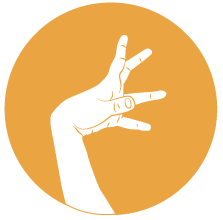
The fingers can also assume an extended and even hyperextended position. When the most proximal joints (metacarpo-phalangeal: MP) and the most distal joints (distal inter-phalangeal: DIP) are in a flexed position, and the middle joints (proximal inter-phalangeal : PIP) are in an hyperextended position, this is referred to as a “swan neck” deformity, due to an imbalance between two different muscle groups (extrinsic and intrinsic muscles).
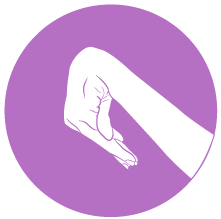
The function of the hand depends on finger deformities, but it is very much influenced as well by the position of the wrist. If the wrist is deformed in hyperflexion, it is mechanically impossible for the fingers to make a fist; even though they are otherwise able to move .
In a number of patients, correcting the position of the wrist improves drastically the capacity of the fingers to seize objects. This can be demonstrated by fitting the patient with a splint that immobilizes the wrist only.
If the finger flexors (muscles which flex the fingers) are contracted, the fingers cannot be opened unless the wrist is brought in flexion.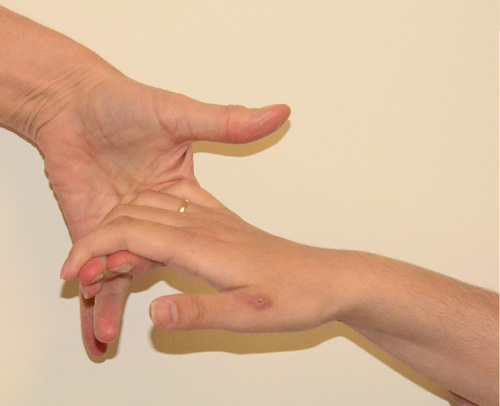
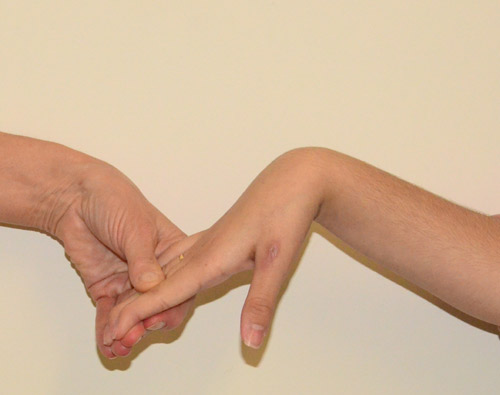
Thumb
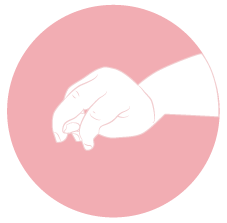
The thumb is often tight along the index finger, or even clenched into the palm because of spasticity of two muscle groups: the intrinsic muscles (adductor, short flexor, opponent) which cause the web space to be closely tight, and the extrinsic muscle (thumb long flexor) which causes the tip of the finger to flex.
This prevents opening of the thumb, even in cases where the muscles extending the thumb are active, and is a good example of the unbalance between the flexors and adductors, spastic and too strong, and the extensors, too weak to fight this hyperactivity. In such cases, not only is pinch between the thumb and the index finger impossible, but the thumb also gets in the way during grasping, preventing the use of the hand.






